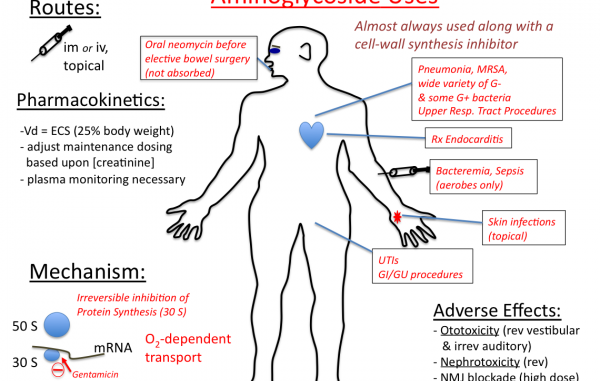
Aminoglycosides: antimicrobial activity, mode of action, mechanism of resistance and pharmacological properties
- Aminoglycosides are aminocyclitol derivative antibiotics. Spectinomycin is the pure aminocyclitol which does not contain amino sugars
Antimicrobial activity of different aminoglycosides:
1. Neomycin and paromomycin:
- Neomycin is limited only for topical application
- Paromomycin is used in the treatment of systemic infection caused by Entamoeba histolytica and Leishmania.
2. Streptomycin:
- Streptomycin have activity against Gram negative, certain gram Positive as well as Staphylococci.
- It is used treatment of Tuberculosis
3. Kanamycin and Amikacin:
- Kanamycina and amikacin are 2nd line drug for Mycobacterium
- Gentamycin, tobramycin, Netilmicin and Amiacin also offer activity against Pseudomonas. These antibiotics are recommended in the treatment of serious systemic infection and endocarditis caused by Streptococci along with broad spectrum β-lactam antibiotics.
Mode of action of aminoglycosides:
- Aminoglycosides block the initiation step of protein synthesis in bacteria. The antibiotics aminoglycodie binds to the P-site in 30S ribosome preventing binding of IF3
- Streptomycin distorts the shape of A-site and therefore interfere with the correct positioning of the incoming aminoacyl-tRNA and thus leads to the misreading of the polypeptide chain in bacteria.
- Streptomycin also causes dissociation of polysomes into monosomes in bacteria
Mechanism of resistance to aminoglycosides:
- Anaerobes are inherently resistant to aminoglycosides. Aminoglycosides requires an active transport system (oxygen dependent) for the uptake of drugs inside bacterial cell. This type of oxygen dependent transport system is absent in anaerobes.
- Mutation in the gene responsible for deletion or alteration of the receptor protein can also leads to development of resistance towards aminoglycosides.
- Alteration of cell surface that interfere with penetration or uptake of drug in bacteria can also leads to resistance.
- Production of enzyme such as aminoglycoside acetyltransferase, aminoglycoside phosphoryltransferase, aminoglycoside adenyltransferase etc by resistant bacteria that inactivates the aminoglycoside either by phosphorylation or adenylation or acetylation. This can also cause resistance to aminoglycosides.
Pharmacological properties of aminoglycosides:
- Aminoglycosides are not suitable for oral administration because they are very poorly absorbed grom GI tract.
- None of the aminoglycoside can cross blood brain barrier.
- These drugs are nephrotoxic and ototoxic.
